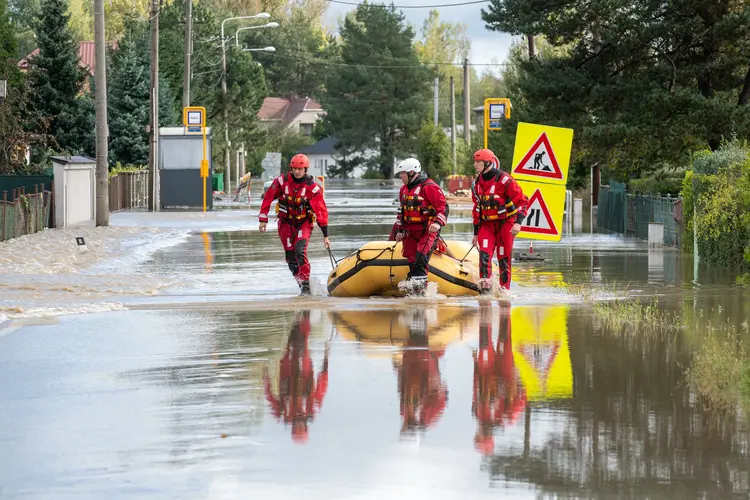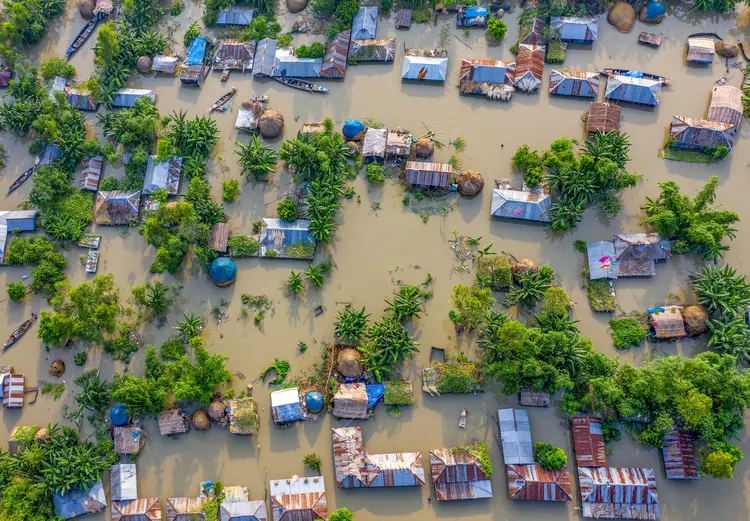
Find out more about flooding across the world, where it is the most prevalent & how climate change makes the weather phenomenon more common
By
Between 1980 and 2021, flooding caused almost 5,600 fatalities and more than €250 billion in losses in EU countries alone. Elsewhere around the world, the impacts of flooding are more prevalent than ever, with floods in Beijing this week leaving 30 individuals dead and more than 80,000 evacuated.
In total, 1.81 billion people are at significant flood risk, with the number expected to rise due to climate change. Globally, these weather events lead to more than $40 billion in damage each year.
But how exactly does our warming planet lead to more floods? Read on to find out exactly how the relationship between climate change and flooding works…
Why is climate change exacerbating flooding?
There are two main types of flooding that occur due to intense rainfall: pluvial (surface water floods) and fluvial (river floods). In addition, coastal flooding is another type, often caused by storm surges.
Enjoying this article? Check out our related reads:
According to the IPCC, climate change has ‘detectably influenced’ several of the variables contributing to floods. One reason why climate change is doing this is because global warming allows the air to hold more moisture. For every 1 °C of warming, the atmosphere can hold seven per cent more moisture.
Once the air rapidly cools, this water vapour turns into droplets that join together to form heavy precipitation. Heavy rainfall in a short period of time is known as flash flooding, while moderate rainfall lasting the duration of several days can overflow rivers and dams
Increasing temperatures from climate change are also melting polar ice caps – a pattern leading to coastal flooding. In the last 25 years, Antarctica has lost around three trillion tonnes of ice, causing global seas to rise by 8mm. In the future, sea levels could rise by a staggering five metres, making occurrences of coastal flooding around ten times more likely.
Climate change is leading to stronger storms, which subsequently bring more intense rainfall along with them. In 2023, Tropical Storm Hilary – the first storm of its kind to hit the West Coast in 84 years – broke rainfall records in Idaho, Montana, Nevada and Oregon.
Back in 2017, Hurricane Harvey made landfall as a Category 4 hurricane, with scientists estimating the hurricane led to around 38 per cent more rainfall than it would have done without climate change.
While you might picture flooding to occur in areas near large bodies of water or coastal communities, there is another type of flooding that occurs right in the middle of a city: urban flooding. This phenomenon occurs when rainfall overwhelms the stormwater drainage capacity of a densely-populated area. One such example of an urban flood was during 2021’s Hurricane Ida, with rainfall completely overwhelming New York City. In total, 11 people living in basement-level apartments died as floodwaters quickly overwhelmed below-ground spaces.

Factors compound on top of floods to make their impacts particularly devastating. For example, soil degradation due to unsustainable development makes it difficult for the land to absorb water from heavy rains. In low-income countries with underdeveloped flood planning and management systems, the presence of both intense rainfall and little flood infrastructure makes for a disastrous combination.
What countries are impacted?
Increased flooding impacts both high and low-income countries alike. In 2023, Somalia, China, the Philippines, Pakistan, Kenya, Ethiopia, India, Brazil, Bangladesh, and Malaysia were all countries that suffered the largest displacement of people from either floods or droughts last year. In that time period, Somalia alone was hit by 223 different flood or drought events, compared to just two in 2013. The Philippines was hit 74 times (compared to just three in 2012), Brazil 79 times (compared to four), and Malaysia 127 times (compared to one in 2013).
In particular, flooding also exacerbates inequalities that women and girls face around the world. When floods do strike, women and children are more likely to die from drowning than men, due to a lack of resources, communication and in some cases, being less able to swim than men.
Flooding can lead to displacement and migration, with women experiencing difficulty living in camps due to specific needs regarding managing periods without access to toilets or clean running water.
Violence against women and girls is also prevalent – and tends to increase – in the wake of a disaster such as flooding, as existing social structures are weakened. Early and forced marriages become more common as families face severe income and livelihood stressors.
What is being done to help?
On the surface, the situation can seem bleak. But many countries and regions are taking flood management into their own hands, devising innovative methods to combat the natural phenomenon.
One such example is the LIFE Metro Adapt Project in Milan, which provided local urban planners with guidelines to apply natural solutions to prevent flooding. Measures created during the project included fitting a public car park with a sustainable drainage system, as well as restoring a canal network to increase water retention capacity.
In Rotterdam in the Netherlands, flood management has included the restoration of river borders, the creation of tidal parks along banks and the installation of rainwater storage systems. These will hold back excess water, allowing it to drain gradually and prevent floods.
In the southwest of the Netherlands, a revival project has restored around 190 hectares of dunes, with the support of EU funding, so that people in the local area can rely on natural defences against the risk of coastal flooding.




